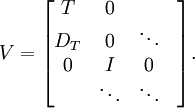Sz.-Nagy's dilation theorem
The Sz.-Nagy dilation theorem (proved by Béla Szőkefalvi-Nagy) states that every contraction T on a Hilbert space H has a unitary dilation U to a Hilbert space K, containing H, with
Moreover, such a dilation is unique (up to unitary equivalence) when one assumes K is minimal, in the sense that the linear span of ∪nUnK is dense in K. When this minimality condition holds, U is called the minimal unitary dilation of T.
Proof
For a contraction T (i.e., ( ), its defect operator DT is defined to be the (unique) positive square root DT = (I - T*T)½. In the special case that S is an isometry, the following is an Sz. Nagy unitary dilation of S with the required polynomial functional calculus property:
), its defect operator DT is defined to be the (unique) positive square root DT = (I - T*T)½. In the special case that S is an isometry, the following is an Sz. Nagy unitary dilation of S with the required polynomial functional calculus property:
Also, every contraction T on a Hilbert space H has an isometric dilation, again with the calculus property, on
given by
Applying the above two constructions successively gives a unitary dilation for a contraction T:
Schaffer form
The Schaffer form of a unitary Sz. Nagy dilation can be viewed as a beginning point for the characterization of all unitary dilations, with the required property, for a given contraction.
Remarks
A generalisation of this theorem, by Berger, Foias and Lebow, shows that if X is a spectral set for T, and
is a Dirichlet algebra, then T has a minimal normal δX dilation, of the form above. A consequence of this is that any operator with a simply connected spectral set X has a minimal normal δX dilation.
To see that this generalises Sz.-Nagy's theorem, note that contraction operators have the unit disc D as a spectral set, and that normal operators with spectrum in the unit circle δD are unitary.
References
- V. Paulsen, Completely Bounded Maps and Operator Algebras, Cambridge University Press, 2003.
- J.J. Schaffer, On unitary dilations of contractions, Proc. Amer. Math. Soc. 6, 1955, 322.





